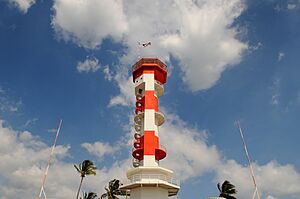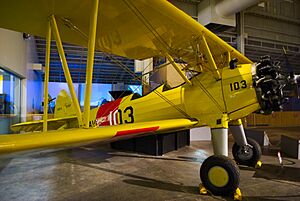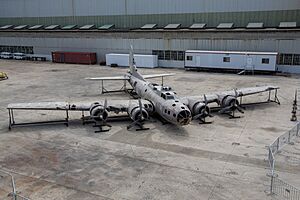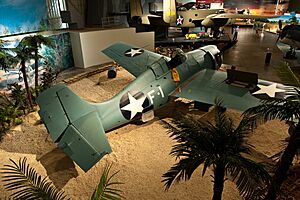Pearl Harbor Aviation Museum facts for kids
 |
|
| Former name | Pacific Aviation Museum Pearl Harbor |
|---|---|
| Established | 1996 |
| Location | Ford Island, Pearl Harbor, Hawaii, United States |
| Type | Aviation museum |
| Collections | Aviation |
| Collection size | 43 aircraft |
| Founder | John Sterling |
| Public transit access | Roberts Hawaii |
The Pearl Harbor Aviation Museum is a special place in Hawaii where you can learn all about airplanes and their history. It used to be called the Pacific Aviation Museum Pearl Harbor. This museum started in 1999 to create a cool aviation museum.
It's located on Ford Island in Pearl Harbor. Many of its exhibits are about the attack on Pearl Harbor and World War II. The museum's buildings, like Hangar 37, still show damage from the attack on December 7, 1941.
The museum also helps the community. It works to save historical places and offers educational tours. Visitors get to the museum by a special bus from the Pearl Harbor Historic Sites. The museum has even won awards for its work in restoring old buildings.
Contents
The Museum's Story
The idea for an aviation museum in Hawaii began a long time ago. In 1983, the Pacific Aerospace Museum opened at Honolulu International Airport. But it closed down later because the airport needed to expand.
Then, in 1995, the idea for the Pacific Aviation Museum started. Senator Daniel Inouye had a big dream for Ford Island. He wanted to bring new life to the island. His plan included new homes and a new museum.
The museum officially opened on December 7, 2006. This was the 65th anniversary of the attack on Pearl Harbor. Important people like former US President George H. W. Bush supported the museum. Famous pilot Chuck Yeager also helped.
The museum covers 16 acres and uses two old airplane hangars, Hangar 37 and Hangar 79. In 2012, it became a partner with the famous Smithsonian Institution. This means it's connected to a network of great museums. By 2013, over a million people had visited the museum!
In 2021, the museum opened a new Aviation Learning Center. It's a 4,000 square foot space where visitors can learn even more about aviation.
Museum Buildings and History

The Ford Island control tower is a very important part of history. It was where the first radio warning of the attack on Pearl Harbor was heard. The museum is working to fix up this old tower. It's a big job that costs over $7.5 million. The tower is 158 feet tall and has been a national historic landmark since 1964. It even appeared in movies like Tora! Tora! Tora! and Pearl Harbor.
Hangar 37 was once a place for seaplanes. It survived the attack on Pearl Harbor. This hangar was the first part of the museum to be developed. It has nine exhibits, a movie theater, and flight simulators. It also has a store and a restaurant.
Hangar 79 is even bigger, at over 87,000 square feet. It's used for restoring old planes. It also has many exhibits, like the flying tigers and MiG Alley displays. You can still see bullet holes in the hangar's glass windows from the Japanese planes during the attack!
Cool Exhibits to See
The museum has many amazing airplanes and exhibits. One cool plane is a Douglas SBD Dauntless. It was restored thanks to a donation from Fred L. Turner, a former CEO of McDonald's.
You can also see a Boeing N2S-3 Stearman. This is the plane that former US President George H. W. Bush used for his flight training. He even flew his first solo flight in a plane like this!
The museum also has parts of a Japanese A6M2 Zero plane. This plane, called "B11-120," crash-landed on Niʻihau island after the second wave of the Pearl Harbor attack. It's displayed exactly as it looked after the crash. You can also see parts of a tractor used to dig trenches on the island. These trenches were made to stop enemy planes from landing there.
Another Japanese A6M2-21 Zero is on display. This type of plane was used in the attack on Pearl Harbor. This specific plane was found in 1968 and restored. It even flew in air shows before coming to the museum in 2006.
One of the most exciting exhibits is the "Swamp Ghost" B-17 bomber. This plane arrived at the museum in 2013, almost 70 years after it avoided the Pearl Harbor attack. It was supposed to fly to Hickam Field on December 7, 1941, but engine trouble delayed it.
Later, the "Swamp Ghost" was used in a bombing mission in 1942. After the mission, it was attacked by Japanese fighters and crashed into marsh water. It stayed there for 64 years, which is how it got its nickname. The wreckage was even used as a landmark for other pilots! It was finally recovered in 2006 and brought to the museum for restoration.
In 2012, the museum also showed off a huge diorama of the Battle of Midway. This amazing model is 10 feet tall and 40 feet wide. It took three years to build and shows a famous battle from World War II.
Aircraft Collection
The museum has a large collection of different aircraft. Here are some of the planes you can see:
- Aeronca Model 65TC
- Bell AH-1 Cobra
- Bell OH-58 Kiowa
- Bell UH-1 Iroquois
- Boeing B-17 Flying Fortress (Swamp Ghost)
- Boeing B-52 Stratofortress (nose section)
- Boeing F/A-18 Hornet
- Boeing Vertol CH-46 Sea Knight
- Boeing N2S-3 Stearman
- Convair F102A Delta Dagger
- Curtiss P-40E Warhawk
- Douglas A3D/NTA-3B Skywarrior
- Douglas C-47 Skytrain
- Douglas SBD Dauntless
- General Dynamics F-16 Fighting Falcon
- General Dynamics F-111C
- Grumman F4F-3 Wildcat
- Grumman F-14D Tomcat
- Grumman TBM Avenger
- Lockheed F-104A Starfighter
- Lockheed T-33 Shooting Star
- McDonnell Douglas F-15C Eagle
- McDonnell Douglas F-4C Phantom II
- Mikoyan-Gurevich MiG-15
- Mikoyan-Gurevich MiG-21
- Mitsubishi A6M2 Model 21 Type 0
- North American B-25B Mitchell
- North American F-86F Sabre
- North American F-86L Sabre
- North American F-100 Super Sabre
- North American T-6 Texan
- Northrop F-5A Freedom Fighter
- Republic F-105 Thunderchief
- Republic RC-3 Seabee
- Sikorsky SH-3 Sea King
- Sikorsky HH-34J Choctaw
- Sikorsky CH-53D Sea Stallion
- Sikorsky SH-60B Seahawk
- Stinson L-13
East, Wind, Rain Film
In 2008, students from Hawaii Pacific University made a 12-minute film called East, Wind, Rain. This film helps museum visitors understand the surprise attack on Pearl Harbor. It even won an award in 2010!
Awards and Recognition
The Pearl Harbor Aviation Museum is a highly-rated place to visit. TripAdvisor listed it as one of the top aviation attractions in the United States. In 2007, the museum won an award for its work in restoring Hangar 37. This award recognized their efforts to save and improve a historic building.
See also
- Onizuka Space Center
- List of aerospace museums
- List of museums in Hawaii





